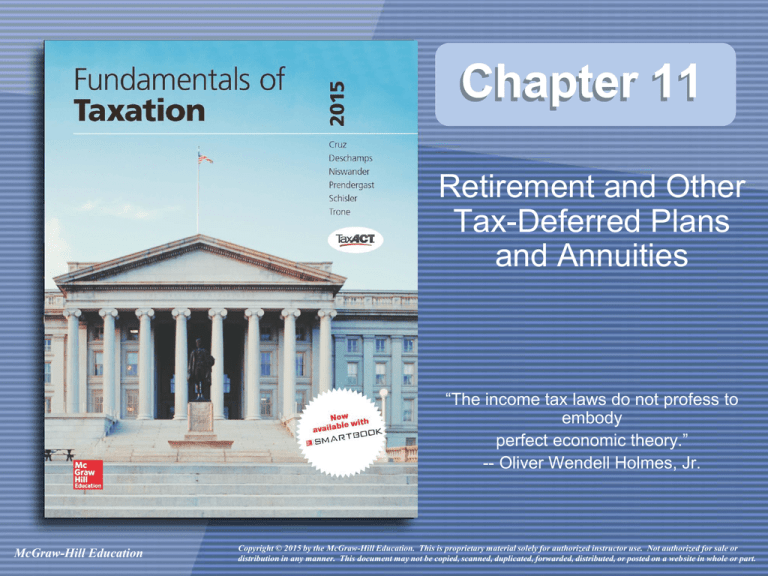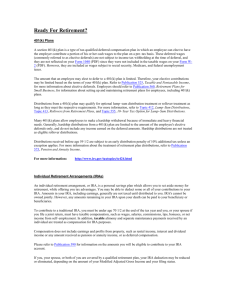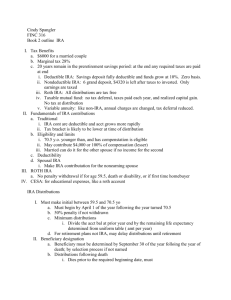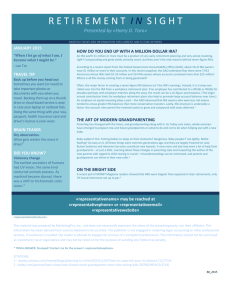11-2 - McGraw Hill Higher Education - McGraw
advertisement

Chapter 11 Retirement and Other Tax-Deferred Plans and Annuities “The income tax laws do not profess to embody perfect economic theory.” -- Oliver Wendell Holmes, Jr. McGraw-Hill Education Copyright © 2015 by the McGraw-Hill Education. This is proprietary material solely for authorized instructor use. Not authorized for sale or distribution in any manner. This document may not be copied, scanned, duplicated, forwarded, distributed, or posted on a website in whole or part. LO #1 – The Basics • Retirement plans are encouraged and receive tax advantages. – Encourage saving for retirement or education – Generally, taxation is deferred (not eliminated) • Retirement plans include employersponsored plans and individual-based plans. 11-2 LO #1 – The Basics • Understand retirement plan terminology – Annuity – Beneficiary – Contributions – Distributions – Donor – Tax-deferred retirement (or other) plan – Trustee • See buzzwords box on page 11-3. 11-3 LO #1 – The Basics • Tax-deferred does not mean tax-free. • Generally, untaxed contributions are taxed when distributed. Previouslytaxed contributions are not taxed on distribution. • Contributions can provide a tax deduction to the person/company that makes them. 11-4 LO #1 – The Basics – Concept Check 11-1 1. Tax-deferred retirement accounts are, essentially, tax-free accounts. False 2. The period in which accumulated assets are paid to plan beneficiaries is known as the _________ period. Distribution 3. A Keogh plan is an example of an individual-based retirement plan. False 11-5 LO #1 – The Basics – Concept Check 11-1 4. Two examples of employer-based retirement plans are _____________ and ___________. Pick any 2 of: qualified pension/profit-sharing, 401(k), 403(b), Keogh, SEP, SIMPLE 5. Distributions from pension plans are taxable if the contributions were made using dollars that were not previously taxed. True 11-6 LO #2 – Employer-Sponsored Retirement Plans • Employer-sponsored plans include: – Qualified pension and profit-sharing plans – 401(k) plans – 403(b) plans – Keogh plans – Simplified Employee Pensions (SEP) – SIMPLE plans 11-7 LO #2 – Employer-Sponsored Retirement Plans • Plans provide benefits to employers and employees – Employer gets immediate deduction for contributions. – Employer contributions are not compensation to employee. – Earnings from plan investments are not taxed when earned. – Plan assets or earnings are not taxable to employee until withdrawn. 11-8 LO #2 – Employer-Sponsored Retirement Plans • Defined-contribution plans pre-establish the amount of the contribution – The amount of the eventual distribution is not known with certainty and will vary. • Defined-benefit plans pre-establish the amount of the benefit – The amount of the contribution is not known with certainty and will vary. 11-9 LO #2 – Employer-Sponsored Retirement Plans • Qualified pension & profit-sharing plans: – Nondiscriminatory, minimum vesting rules, contributory or noncontributory – Additions to defined-contribution plan can’t exceed lower of $52K or 100% of compensation – Additions to defined-benefit plan can’t result in benefits more than the lower of $210K or 100% of compensation 11-10 LO #2 – Employer-Sponsored Retirement Plans • 401(k) plans – Must meet nondiscrimination rules – Employee can elect to defer up to $17,500 (additional $5,500 if age 50 or over) • Keogh plans – For self-employed – Contribution limits generally the same as qualified plans 11-11 LO #2 – Employer-Sponsored Retirement Plans • Simplified Employee Pensions (SEP) – Employer creates and contributes to employee IRAs – Maximum contribution is lower of 25% of compensation or $52,000. • SIMPLE plans – Employer creates IRA or 401(k) for employee – Employee contributes a % up to $12,000 (additional $2,500 allowed if age 50 or over) – Employer makes matching contribution of 3% for all employees or 2% for all eligible employees. 11-12 LO #2 – Employer-Sponsored Retirement Plans – Concept Check 11-2 1. Qualified pension plans are either defined-_______ plans or defined-_______ plans. Benefit; contribution 2. Employees must make contributions to qualified pension plans. False 3. The maximum contribution to a 401(k) plan is _______ for individuals under age 50. $17,500 11-13 LO #2 – Employer-Sponsored Retirement Plans – Concept Check 11-2 4. A Keogh plan can be used by selfemployed individuals. True 5. A SIMPLE plan can be used by employers with 100 or fewer employees who also meet other requirements. True 11-14 LO #3 – Individual-Sponsored Retirement Plans • Traditional Individual Retirement Account (IRA) and Roth IRA. • Contributions limited to smaller of $5,500 or 100% of compensation. If age 50 or over, the dollar limit is $6,500. 11-15 LO #3 – Individual-Sponsored Retirement Plans • Individuals covered under an employer plan – Deductible contribution amount begins to phase out when AGI reaches $96K (married) or $60K (others) and is fully phased out at $116K and $70K, respectively. • Married filing separately, the phase out starts at $0. – Can still make nondeductible contribution up to the $5,500 or $6,500 limits 11-16 LO #3 – Individual-Sponsored Retirement Plans • Married taxpayers – If both employed and neither are covered under an employer plan, then both spouses can make a deductible IRA contribution up to the $ limits. – If only one spouse is employed and that person is not covered under an employer plan, can contribute up to the maximum for both persons. – If one spouse is covered under an employer plan, and the other is not, the non-covered spouse can contribute up to the dollar limits if AGI < $181,000. 11-17 LO #3 – Individual-Sponsored Retirement Plans • Roth IRA contributions are not deductible but withdrawals are not taxable • Contribution limits are the same as with a traditional IRA • Phase out starts at $181K (MFJ), $114K (single or HoH), $0 (MFS) – Phase out range is $10K MFJ, $15K others 11-18 LO #3 – Individual-Sponsored Retirement Plans • Traditional IRA vs Roth IRA – Contributions are deductible for traditional IRA but not for Roth IRA – Distributions are taxable for traditional IRA but not for Roth IRA • Taxpayers are trading off the nondeductibility of contributions against the non-taxability of distributions. 11-19 LO #3 – Individual-Sponsored Retirement Plans – Concept Check 11-3 1. Two types of individual-sponsored retirement plans are ______________ and ____________. Traditional IRA and Roth IRA 2. A single individual, age 58, with wages of $30,000 can make a tax-deductible contribution of up to $_______ to a traditional IRA. $6,500 3. A married couple with earned income of $200,000 is ineligible to make a deductible contribution to a traditional IRA. True or false? False 4. Generally, distributions from a Roth IRA are not taxable. True or false? True 11-20 LO #4 – Tax-Deferred Nonretirement Plans • Coverdell Education Savings Account (CESA) – Contributions not deductible, account grows tax-free, distributions are not taxable if used exclusively to pay higher education expenses of beneficiary. – Any person can establish and fund a CESA for any person, him or herself included. 11-21 LO #4 – Tax-Deferred Nonretirement Plans • CESA contributions limited to $2,000 per beneficiary – From all sources combined • Contributions phased out when AGI of contributor reaches $190K (MFJ), $95K others. – Totally phased out at $30K or $15K above those numbers, respectively. 11-22 LO #4 – Tax-Deferred Nonretirement Plans – Concept Check 11-4 1. Contributions to Coverdell Education Savings Accounts (CESAs) are not deductible. True or false? True 2. The maximum annual contribution to a CESA is $___________. $2,000 3. Contributions to CESA accounts begin to be phasedout when AGI reaches $__________ for a single taxpayer. $95,000 11-23 LO #5 - Distributions • Generally, distributions are taxable if contributions were deductible. • When some (but not all) contributions were made with previously taxed dollars, then distributions will be partially tax free and partially taxable. Use simplified method. 11-24 LO #5 - Distributions • Simplified method. For cases where distributions are partially taxable. – Determine number of anticipated payments using single life or dual life tables in text – Determine total contributions from previously-taxed dollars. – Fraction: previously taxed $ / # payments – Fraction represents proportion of each payment that will be tax-free. 11-25 LO #5 - Distributions • Other plans have required minimum distributions (RMD) that must begin by April 1 of year following the year taxpayer reaches age 70.5. • RMD is based on life expectancy tables from IRS (normally Table III in text) • Use these IRS tables to determine life expectancy each year. 11-26 LO #5 – Distributions – Concept Check 11-5 1. A participant in a defined-benefit plan is only entitled to only a stream of payments. True 2. Distributions from qualified pension plans may be taxable, nontaxable, or both. True 3. The number of anticipated payments from a pension plan for a single individual, age 68, is ______. 210 4. The number of anticipated payments from a pension plan for a married couple ages 59 and 63 is ______. 310 5. Distributions are required from a traditional IRA. True 11-27 LO #5 - Distributions • Roth IRA distributions are generally not taxable. – Earnings are taxable if withdrawn prior to an initial five-year holding period. • Coverdell Education Savings Account distributions are tax-free if used to pay for qualified education expenses of beneficiary. – Can’t use education expenses paid by CESA also for American Opportunity/Hope or lifetime learning credits 11-28 LO #5 - Distributions • Premature distributions generally subject to 10% penalty. – Some exceptions apply. See page 11-17 • Rollovers are generally tax-free. Rollovers to a Roth IRA are taxable. – If rollover $ are distributed to the taxpayer, there is a 60-day window to deposit $ in new plan. Otherwise, the entire amount is taxable. 11-29 LO #5 – Distributions – Concept Check 11-6 1. IRA distributions are taxable if funded with deductible contributions. True 2. Distributions are never required from a Roth IRA. True 3. For an individual age 65, Roth IRA distributions are not taxable if they have been held for at least five years. True 4. Distributions from Coverdell Education Savings Accounts can be used for any purpose once the beneficiary reaches age 30. False 11-30 LO #6 - Annuities • An annuity is a series of payments pursuant to a contract. • Normally, annuity payments are partially taxable and partially tax-free to recipient 11-31 LO #6 - Annuities • The tax-free component is based on the cost of the annuity contract and expected return • The cost of the annuity contract is the amount the recipient paid for the contract. – The portion of the payments that is represented by the cost of the contract is tax-free. 11-32 LO #6 - Annuities • The expected return is the total amount the recipient anticipates receiving over the annuity contract. – For contracts that will last a specified amount of time, the expected return is the periodic payment × the number of payments. – For contracts that will provide payments for life, the recipient must refer to the life expectancy tables to determine length of time. 11-33 LO #6 – Annuities – Concept Check 11-7 1. An annuity is a ______ of payments under a ______. Series; contract 2. Annuity payments are always the same amount each period. False 3. Annuity payments often have a taxable component and a nontaxable component. True 11-34




